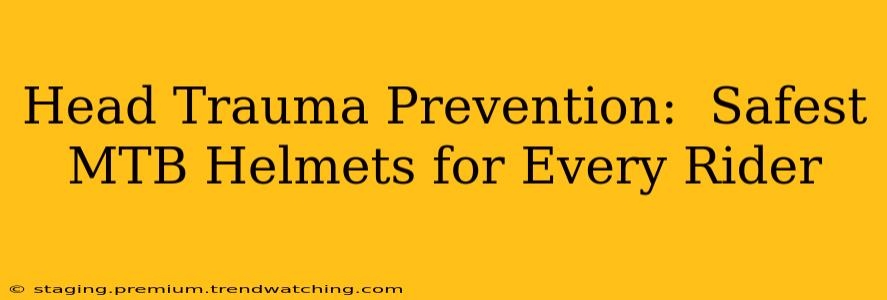Mountain biking is an exhilarating sport, but it comes with inherent risks. Head injuries are a serious concern, making helmet selection paramount. This guide explores head trauma prevention in mountain biking, focusing on choosing the safest MTB helmet for your individual needs and riding style. We'll delve into crucial safety features, different helmet types, and factors to consider for optimal protection.
What are the most important safety features to look for in an MTB helmet?
Choosing a safe MTB helmet involves understanding key features. Look for helmets with:
-
Multi-Impact Protection: Many helmets offer single-impact protection, meaning they're designed to absorb one significant impact. However, increasingly, helmets incorporate technology to handle multiple smaller impacts, better suited to the cumulative forces experienced in mountain biking. Look for helmets mentioning this feature.
-
MIPS (Multi-directional Impact Protection System) or similar technology: MIPS is a leading technology that allows the helmet liner to rotate independently of the outer shell during an impact, reducing rotational forces on the brain. Other similar technologies exist, so research alternatives if MIPS isn't in your budget.
-
ASTM and CPSC Certification: Ensure the helmet carries certifications from organizations like the American Society for Testing and Materials (ASTM) and the Consumer Product Safety Commission (CPSC). These certifications signify that the helmet has met specific safety standards.
-
Proper Fit and Ventilation: A helmet that fits poorly won't offer adequate protection. It should fit snugly but comfortably, allowing for minimal movement. Good ventilation is vital to prevent overheating, especially during strenuous rides.
-
Durable Construction: The shell should be made from robust materials resistant to impacts. Look for information about the shell construction material and its impact resistance capabilities.
What type of MTB helmet is best for different riding styles?
The ideal helmet depends on your riding style:
-
Trail Riding: For trail riding, a full-face helmet offers maximum protection, especially for more aggressive riders tackling technical terrain. However, a lighter half-shell helmet might be preferred for less demanding trails.
-
Downhill/Enduro: Downhill and enduro riding demand the highest level of protection. A full-face helmet is essential here, with features like reinforced chin bars and extra padding.
-
Cross-Country: Cross-country riding typically involves less aggressive terrain. A lightweight half-shell helmet with good ventilation is often sufficient.
-
BMX/Dirt Jumping: Similar to downhill, BMX and dirt jumping require a full-face helmet capable of withstanding high-impact collisions.
How often should I replace my MTB helmet?
Helmets should be replaced after any significant impact, even if damage isn't visible. The internal structure might be compromised, reducing its protective capacity. Additionally, manufacturers typically recommend replacing helmets every 3-5 years, depending on usage and storage conditions. UV exposure and general wear and tear can also degrade a helmet's protective properties over time.
Can I use a road bike helmet for mountain biking?
No, road bike helmets are not suitable for mountain biking. They are designed for different impact scenarios and generally lack the robust construction and protection needed for the more aggressive nature of mountain biking. Road helmets usually prioritize weight and ventilation over impact resistance, leading to potentially insufficient protection in a mountain biking crash.
What is the best way to ensure my helmet fits properly?
Proper fit is crucial for optimal protection. When trying on a helmet, ensure it sits level on your head, with the straps snug but not restrictive. The helmet should cover your forehead, and the straps should form a "V" shape under your ears. If unsure, seek professional advice from a bike shop specializing in helmet fitting. Don’t rely solely on the sizing chart; always try before you buy.
What are some tips for preventing head injuries while mountain biking?
Beyond helmet selection, preventative measures are crucial:
- Ride within your skill level: Avoid riding terrain that exceeds your capabilities.
- Check your bike regularly: Ensure your bike is in good working order to minimize the risk of accidents.
- Be aware of your surroundings: Pay attention to trail conditions, obstacles, and other riders.
- Take breaks when needed: Avoid fatigue, which can impair judgment and reaction time.
- Wear appropriate protective gear: This includes not just a helmet but also gloves, elbow pads, and knee pads.
Choosing the right MTB helmet is a vital aspect of head trauma prevention. By understanding the different features, styles, and best practices, mountain bikers can significantly reduce their risk of serious injury, ensuring a safer and more enjoyable riding experience. Remember, your safety is paramount. Invest in a quality helmet that fits perfectly and suits your riding style, and always prioritize safe riding practices.

